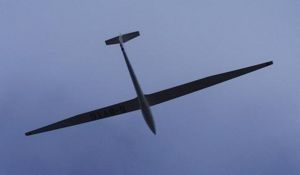PlaneSpottingWorld welcomes all new members! Please gives your ideas at the Terminal.
Glaser-Dirks DG-400
| A 17-metre span DG-400 | |
| Type designation | DG-400 |
| Competition class | 18 metre |
| Number built | 290 |
| Crew | 1 |
| Length | 7 m |
| Height | m |
| Cockpit width | 0.62 m |
| Cockpit height | 0.81 m |
| Wingspan | 17 m |
| Wing area | 10.57 m² |
| Aspect ratio | 27.34 |
| Wing profile | FX 67-K-170 |
| Empty mass | ca. 310 kg equipped |
| Water ballast | 90 kg |
| Maximum mass | 460 kg |
| Wing loading | ca. 37 - 43.5 kg/m² |
| Maximum speed | 270 km/h |
| Maneuver speed | 190 km/h |
| Minimum sink | ca. 0.54 m/s |
| Glide ratio | 45 |
| Roll rate | ca. 3.5 - 4 s (-45º to +45º) |
| Engine type | Rotax 505 2 cylinder 2 stroke |
| Engine power | ca. 43 hp |
| Fuel tanks | 20 litres (50 as option) |
| Take-off run | ca. 170 m (460 kg, ISA) |
| Distance to clear 15 m obstacle |
ca. 270 m (460 kg, ISA) |
| Climb rate | m/s (sea level) m/s (at 3000 m) |
| Best climb speed | 90 km/h |
| Range in 'saw-tooth' operation | 380 km with 20 l |
The Glaser-Dirks DG-400 is a single-seat self-launching motorglider that was produced by Glaser-Dirks between 1981 and 1990. It was the first self-launching motorglider with retractable engine and propeller to be produced in large numbers.
History
The cost of carbon-fibre had fallen enough in the late 1970's to allow its use in the wing spars of high-performance gliders. Glaser-Dirks introduced a carbon wing variant of the DG-200 about this time. The designer, Wilhelm Dirks, realised that the span, strength and very low weight of this wing allowed for a self-launching engine to be carried in the glider without an unacceptable penalty when soaring in weak conditions. The DG-400 was created as a result. Its first flight took place in May 1981.
The DG-400 uses the wings and most systems of the DG-202. It has a modified fuselage with a slightly enlarged boom and carbon fibre reinforcements to accommodate the engine, which is a relatively large unit with electric starter and electric retraction. This powerful installation, associated with a user-friendly engine control unit, ensured that the DG-400 was significantly safer and easier to operate than other self-launching gliders.
As was typical for the time, the engine, propeller and supporting pylon constitute a single unit that extends into the airflow (in more recent self-launchers the engine usually stays inside the fuselage). The type may be flown either with 15 metre or 17 metre wingtips.
The DG-400 was not aimed at competitions, but rather at leisure flying. Nevertheless, several World Gliding Records have been achieved flying this type.
Sources
Lists relating to aviation | |
|---|---|
| General | Timeline of aviation · Aircraft · Aircraft manufacturers · Aircraft engines · Aircraft engine manufacturers · Airports · Airlines |
| Military | Air forces · Aircraft weapons · Missiles · Unmanned aerial vehicles (UAVs) · Experimental aircraft |
| Notable incidents and accidents | Military aviation · Airliners · General aviation · Famous aviation-related deaths |
| Records | Flight airspeed record · Flight distance record · Flight altitude record · Flight endurance record · Most produced aircraft |

